Indonesia: Emerging as a Leader in Aquaculture
EDITOR’S NOTE: As you’ll note on page 6 of this issue, ASIAN PACIFIC AQUACULTURE 2024 will be held i...
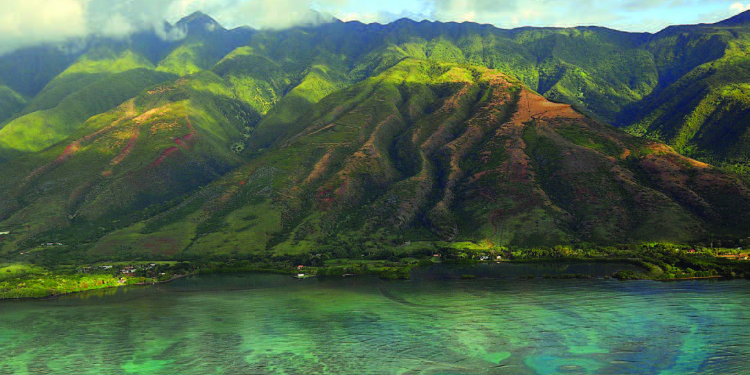
Development of Hawaiʻi’s aquaculture industry was influenced early on by several key factors, beginning with the long history of aquatic farming by indigenous Hawaiians prior to Western contact. The ethnic diversity stemming from immigration, early investment in research and development and the availability of a wide range of species, systems and natural resources made Hawaiʻi a living laboratory for experimentation and innovation. The result today is a vibrant aquaculture landscape combining ancient and new practices. Dozens of animal and plant species have been successfully cultured and new technologies are constantly emerging.
Hawaiʻi has a proud history of aquaculture that begins around 1200 A.D. when Hawaiians began building four types of fishponds. Around 488 ponds are estimated to have existed prior to 1788 (DHM 1990). Ponds were managed extensively and were part of larger, integrated food production systems based on watershed management (ahupua`a). The ahupua`a system supported a population of over one million prior to Western contact.
This legacy continues today with the restoration of ancient pond infrastructure and revival of aquaculture production in the ponds (Fig. 1). These historic and cultural treasures serve as a persistent reminder of aquaculture’s potential in the islands and challenge modern aquaculture practitioners, given that the ponds that existed prior to colonization produced an estimated 2 million pounds of fish annually (Kikuchi 1973, Costa-Pierce 1987), far more than modern aquaculture practices produce today.
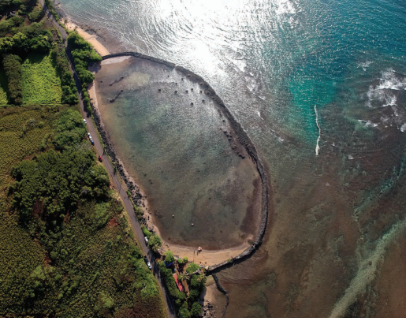
FIGURE 1. The Kahina Pōhaku Hawaiian fishpond at Moanui, Molokai, an example of the kuapā type of Hawaiian fishpond where the stone wall extends into the inter-tidal zone. These ancient ponds have been used for centuries and many are now being restored for aquaculture. Photo: Scott Kanda, courtesy of Ku ʻāina Ulu ‘Auamo.
Most of Hawaiʻi’s aquaculture production in the 19th and 20th century continued to be land-based using the ancient fishponds and the traditions of earthen pond aquaculture brought from Asia. As late as 1901, 430,115 pounds of milkfish (awa, Chanos chanos) and 430,115 pounds of striped mullet (‘ama’ama, Mugil cephalus) were harvested annually (Hiatt 1944). Other species such as common carp, grass carp, koi, rainbow trout and Chinese catfish were introduced in the 1800s, followed by a spate of introductions in the 1950s and 1960s of a wide variety of marine and freshwater species for fisheries enhancement and aquaculture. Four species of tilapia were introducedin the 1950s (Syzper et al. 2000, Johnston and Purkis 2016). Although the introductions greatly increased the number of available culture species, some also resulted in environmental impacts that continue to influence public perceptions of aquaculture.
A turning point came in the 1960s as the potential to use marine resources for food production and alternative energy came to public awareness. The State government and other stakeholders began to make important decisions and investments that continue to make Hawaiʻi an attractive location for aquaculture production and research today. The State’s first aquaculture facility was established in 1959 as the Keehi Bait Station by the Department of Land and Natural Resources. The initial focus was on producing baitfish, including tilapia, for the fishing industry. This station was later renamed as the Anuenue Fisheries Research Center (AFRC) and was moved to Sand Island, Honolulu. Other State facilities such as Hawaiʻi Ocean Science and Technology Park (HOST Park) administered by the Natural Energy Laboratory of Hawaiʻi Authority (NELHA) in Kailua-Kona and the Hawaiʻi Institute of Marine Biology (University of Hawaiʻi) followed.
The state government took other steps to plan and build capacity for aquaculture expansion by establishing the Aquaculture Development Program (ADP), which implemented the first state aquaculture masterplan in the U.S. (Aquaculture Planning Program 1978), adopted in 1979 by the State Legislature (Ogata 1982). This plan was then updated and expanded in 1993 as “Hawaii’s Future in Aquaculture: Strategy for the Blue Revolution” which described Hawaiʻi’s role in the expansion of global aquaculture (Corbin 2007). The latter publication played a key role in guiding aquaculture development into the 21st Century and much of it is still relevant today. This Plan also recognized that aquaculture research and technology transfer activities were a potentially important economic driver (Corbin 2007).
The 1960s and 1970s were a period of intense and coordinated research activity carried out by several institutions, with State and Federal funding, much of which aimed at determining which specieswere most appropriate for local conditions. Several achievements stand out as examples of how the early investments in infrastructure and planning paid off. One of the first was the development of culture methods for the Malaysian prawn Macrobrachium rosenbergii at the AFRC, which created a small industry. Other notable research efforts included closing the life cycle of striped mullet Mugil cephalus, which then led to the development of another native species, Pacific threadfin Polydactylus sexfilis, known in Hawaiian as moi, by the Oceanic Institute (OI). Work also began on designing sea cages for open-ocean aquaculture in the 1960s which, in combination with mass culture hatchery methods, eventually led to the first open-ocean commercial aquaculture lease in marine waters of the U.S. to farm moi in 1999 (Cates 2006, Helsley 2007). A panoply of other fish, invertebrate and algae species were also tested for aquaculture potential, offering a wide range of species that can be successfully cultured.
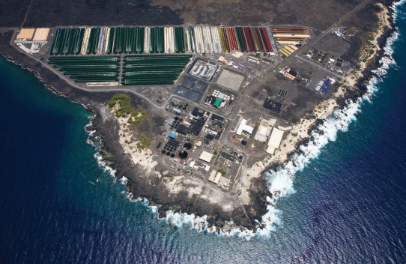
FIGURE 2. The HOST Park located at Keahole Point, near Kailua-Kona. The largest aquaculture companies operated here due to the availability of deep ocean water and other services. Photo: Shaun Moss.
There is now a well-established knowledge base for production of common aquaculture species such as the tilapias in Hawaiʻi, as well as for unique, native species with high economic potential. The Hawaiian Islands also have every known climatic condition except for tundra, and an abundance of fresh, brackish and saltwater resources. The latter includes the cold, deep ocean water provided by HOST. These factors combine to create dozens of possible scenarios for commercial aquaculture awaiting investment and further development. Moreover, the availability of collaborative research facilities and trained personnel make Hawaiʻi one of the best places to carry out aquaculture R&D.
The demand for seafood in Hawaiʻi is 37 lb/capita or slightly more than twice the 16 lb/capita for the U.S. population as a whole. Of the 50.4 million lb/yr consumed in the state, approximately 49 percent is imported (Loke et al. 2012). The opportunity to produce and market any aquatic product locally is nearly unlimited in terms of consumer acceptance and demand, given the multicultural resident population and the nearly 10 million visitors per year who crave seafood (DBEDT 2018). Thus far, export products have only been successfully developed in a few cases, primarily due to high production and shipping costs in an island setting. Consequently R&D efforts have been oriented towards high-value specialty products, most of which were identified initially more than 50 years ago. The top aquaculture products in terms of farm-gate value are microalgae, shrimp broodstock and bivalve seed, none of which contribute directly to increasing local seafood supply. Small-scale, backyard and aquaponics operations do contribute to local food security by supplying fish and vegetables. There were 88 aquaculture farms in 2017, with 15 of these accounting for 75 percent of annual sales (NASS 2018).
The total value of aquaculture products from Hawaiʻi was $76.367 million in 2017 (2018 NASS) and the industry employed 462 workers. Microalgae production accounts for $35.2 million (46 percent of total production). Cyanotech Corporation, a vertically integrated company, is the largest producer of microalgae products, including BioAstin® Natural Astaxanthin and Hawaiian Spirulina Pacifica for the nutraceutical industry.
As there are relatively few large companies in Hawaiʻi, data for shellfish, fish and other products are lumped into the “other” category to protect proprietary information but this category represents 54 percent ($41.177 million) of total aquaculture value. Most are exports of shellfish seed and shrimp broodstock. Shrimp broodstock exports were estimated at 800,000 animals in 2015 with a value of $100 per pair. In the same year, shrimp broodstock became Hawaiʻi’s top export, replacing bottled water (Shrimp News International 2016, Honolulu Star Advertiser 2015). Hawaiʻi ranks sixth or seventh in farm gate value among the 48 U.S. states that produce aquaculture products.
An important force in the expansion of aquaculture in Hawaiʻi is the presence of several major facilities that host research, training and extension activities related to aquaculture. The “crown jewel” of these is the HOST Park administered by NELHA located in Kailua-Kona on Hawaiʻi Island (Fig. 2). Designed to facilitate energy and aquaculture-based economic development, the park includes infrastructure for the distribution of deep and surface seawater to 870 acres of land and a 3,290-acre adjacent marine research corridor. A wealth of pre-permitted site conditions makes it an ideal location for aquaculture R&D. The tech park currently hosts around 50 companies, including approximately 20 aquaculture companies, many of which are among the oldest and most successful in Hawaiʻi. Among the species commercially produced at HOST Park are microalgae, abalone, marine fish, bivalves, seaweed, ornamental fish, seahorses and octopus. Many of the aquaculture tenants are active in research and commercial production. HOST Park has grown steadily over the years since the 1970s.
HOST Park provides a dynamic aquaculture ecosystem and continues to accept new innovative projects and companies on its remaining available 200 acres. It offers many critical resources to new start-up companies, including business services, laboratory services and turnkey facilities. Recently, a specialized accelerator program run by HATCH Aquaculture Accelerator was established. The first HATCH cohort program started in August 2019 at HOST Park and included visits to Norway and Singapore (the other two HATCH hubs). Thirteen companies with globally impacting technologies were selected for the first cohort and are eligible for follow-on funding as part of the program.
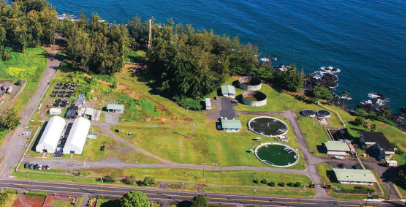
FIGURE 3. The Pacific Aquaculture and Coastal Resources Center, University of Hawaiʻi Hilo, located in Keaukaha, Hilo. The Center is based at a rehabilitated wastewater treatment plant. Photo: University of Hawaiʻi.
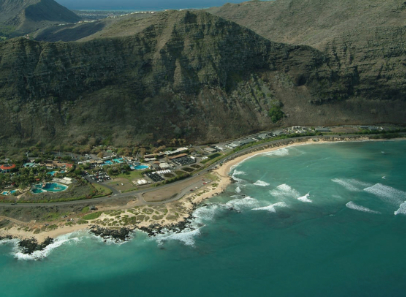
FIGURE 4. Oceanic Institute of Hawai‘i Pacific University covering 56 acres in Waimanalo, Hawaiʻi with the Ko’olau Mountains in the background. Sea Life Park, a public exhibit featuring local marine life, is located on the left side of the photo. Photo: Oceanic Institute.
The Pacific Aquaculture and Coastal Resources Center (PACRC) of the University of Hawaiʻi Hilo (UHH) on the east side of Hawaiʻi Island was developed from a rehabilitated wastewater treatment facility and has some of the largest tanks in the State. It is a Center of Excellence for Sustainable Aquaculture in partnership with the University of Hawaiʻi Sea Grant Program. Its two sites include a 9-acre location on Hilo Bay for marine aquaculture (Fig. 3) and a smaller inland facility for freshwater aquaculture. The PACRC hosts three hatcheries (two for marine fish and one for bivalves), resources for seaweed, corals and a wide variety of research and training efforts. It is widely used by academic, public- and private-sector partners and has an active international technical assistance program. UHH offers the only four-year program for aquaculture in the State as a specialization in its Bachelor of Science in Agriculture, Forestry and Natural Resource Management.
The University of Hawaiʻi System has three other facilities used for aquaculture and related topics. The Hawaiʻi Institute of Marine Biology (HIMB) is located on Coconut Island near Kāneʻohe. Among the many important recent contributions is the development of temperature-resistant corals by the late Dr. Ruth Gates. Other HIMB researchers continue to make research contributions related to the biology and ecology of aquaculture species. The Waikiki Aquarium is also an important generator of information on aquaculture species and has a long history of training individuals, many of whom became active in research andcommercial farming.
The College of Tropical Agriculture and Human Resources (CTAHR) is currently developing an on-campus facility, the Tuahine Aquaculture Research and Education Center (TAREC) at UH Mānoa that will provide resources for research, extension and education. CTAHR is the designated Land Grant entity in Hawaiʻi and hosts cutting-edge fundamental and applied research projects employing tilapia as a model organism. Undergraduate and graduate students are exposed to aquaculture research through graduate programs in Animal Sciences and Nutritional Research, access to state-of-the-art laboratories and approaches and a range of local and international collaboration opportunities. Projects include studies on environmental physiology, growth, osmoregulation, endocrinology, toxicology, nutrition, stress response, genetics, feeds development and aquaponics.
The University of Hawaii Animal Diagnostic Laboratory (UHADL) was created to perform disease testing to meet the needs of exporters of live aquacultured animals. Currently, the laboratory is in the process of obtaining USDA approval. With a projected start-up date in 2020, the new testing capability will greatly facility the export of SPF/SPR shrimp, shellfish seed and other products.
Oceanic Institute of Hawaiʻi Pacific University (OI) is one of the best-known aquaculture research and training facilities in the world given its role in supporting aquaculture development on the international stage (Fig. 4). Founded in 1962, many of the most innovative breakthrough efforts in aquaculture were started there, including development of SPF shrimp broodstock, which drastically changed the species choice of shrimp production in Asia and fosteredlocal export industry, marine fish reproduction and larval rearing, fish nutrition and feed production and some of the earliest sea-cage research. HPU offers bachelors and master’s degrees in marine science which includes many opportunities for students to obtain hands-on experience with aquaculture at OI.
The Division of Aquatic Resources (State of Hawaiʻi) continues to operate at the Anuenue Fisheries Resource Center located on Sand Island, Honolulu (Fig. 5). One of its earliest activities was to produce fish such as mullet for restocking efforts and it now houses a sea urchin hatchery and coral nursery.
Hawaiʻi’s aquaculture activities are closely tied to activities in the U.S. Affiliated Pacific Islands (USAPI) which include the territories of American Samoa and Guam, the Commonwealth of the Northern Marianas Islands (CNMI) and the freely associated nations of the Republic of the Marshall Islands, Federated States of Micronesia (FSM) and the Republic of Palau. One of the most active extension and research programs is based at the Marine and Environmental Research Institute of Pohnpei (MERIP) in FSM which supports community-based production of giant clams, sponges, corals and rabbitfish in the USAPI. The Palau Mariculture Development Center (PMDC) is now the largest aquaculture facility in the USAPI after a recent renovation and was important in the development of giant clam culture. It continues to play this role and is also engaged in development of rabbitfish, sea cucumbers and mud crab, many of which were supported by the USDA Regional Aquaculture Center (CTSA), based in Honolulu. There are also U.S.-accredited community colleges in the USAPI and one four-year university (University of Guam), all of which offer either marine science or aquaculture training.
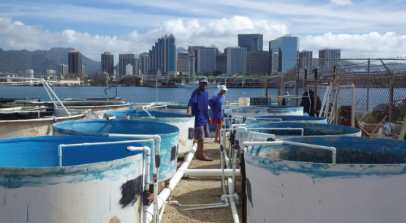
FIGURE 5. The Anuenue Fisheries Research Center (AFRC) on Sand Island, Honolulu. Shown here is Wally Ito with tanks of native species of seaweed. Photo: Wally Ito.
Demonstration of commercial-scale open-ocean mariculture has been one of Hawaiʻi’s most impactful contributions to U.S. aquaculture (Fig. 6). Early research on this production system, particularly the initial environmental assessment and siting requirements (Helsley 2007), set the stage for mainland efforts to establish offshore farms in the U.S. Two commercial offshore cage projects for marine fish culture have been successfully deployed inHawaiʻi. In 2001, four cages were located by Cates International Inc. off Ewa Beach, Honolulu and produced moi until 2010.
Kona Blue Water Farms was established in 2004, with the first harvest of their trademarked Kona Kampachi (longfin amberjack Seriola rivoliana, Fig. 7) in 2005, from a site located about 1 mile north of Keāhole Point, in around 65 m deep water. By 2008, the company was producing 500 t per year, and grossing over $6 million annually, from eight submersible Sea Station cages, each 3,000 m3. The offshore operation and land-based hatchery were acquired in 2009 and 2010, respectively, by Blue Ocean Mariculture (affiliated at that time with the owners of Ocean Spar). The company continues operation today, using five Sea Stations, each between 6,000 and 8,000 m3.
A pilot pearl farm was established in 2006 near the moi cage farm but later closed. Another effort tried to establish a tuna farm on the Kohala Coast of the Island of Hawaiʻi, but this was discontinued after community opposition during the permitting process. Permitting continues to be a major consideration for offshore farming, in part due to public opposition and misinformation about environmental impacts of cage culture. The tremendous potential offered by open-ocean cage farming to increase local seafood production using state-of-the art best management practices and to reduce the carbon footprint of imported seafood has yet to be realized but the foundation has been laid.
Kailua-Kona is the site of yet another pioneering offshore aquaculture effort in federal waters (beyond the 3 nm line). In 2011, Kampachi Farms LLC deployed the Velella Beta-test – a 20-ft diameter Aquapod, the world’s first unanchored net pen, designed to remain entrained within eddies in the western (lee) side of Hawaiʻi Island (Fig. 8). This was possibly the world’s first ever so-called ‘drifter-cage’ and was accorded recognition by TIME Magazine and highlighted in Dr. Bob Ballard’s National Geographic special “Alien Deep.” It was also the first harvest of kampachi from an aquaculture net pen in U.S. Federal waters. In 2013, the company deployed the same net pen, stocked again with kampachi, onto a single-point mooring in 6,000 feet of water, 6 miles offshore of Keauhou Bay. The Velella Gamma was able to be run remotely from cloud connections, using a wi-fi bridge to the feed barge attached to the net pen array. Technicians only needed to visit the farm site once a week to top up feed in the hopper and fuel the generator. Both of these Velella projects were also important in establishing precedent for permitting of aquaculture in federal waters (between 3 nm and 200 nm). A spin-off company – Forever Oceans – continues to refine the remote command-and-control technologies using innovative net pens at the site offshore from Keauhou Bay.
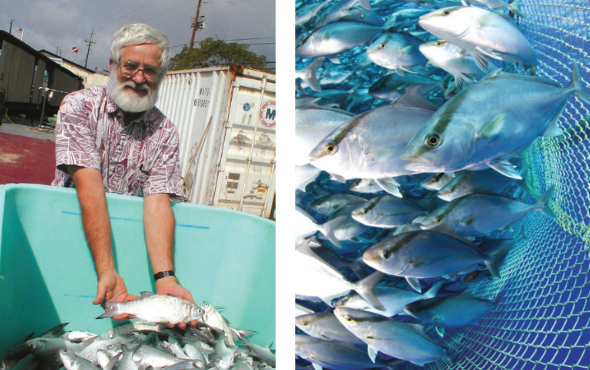
FIGURE 6. Dr. Charles “Chuck” Helsley holding a cultured moi (Polydactylus sexifilis). Dr. Helsley led the early research on the feasibility and environmental impacts of open-ocean cage culture, circa 2003.
FIGURE 7. Almaco jack (Seriola rivoliana), known as kahala in Hawaiian, are grown in cages owned by Blue Ocean Mariculture and are located just offshore of Kailua-Kona, Hawaii Island. Fish are marketed as “Hawaiian Kanpachi”. Photo: Blue Ocean Mariculture.
A very recent innovation is the planned development and operation of an offshore seaweed farm, “Blue Fields Offshore Macroalgae (limu) Demonstration Project” consisting of a submerged platform tethered in 120-ft deep water, 1.5 miles offshore of Keāhole Point near Kailua-Kona. Seaweeds will receive nutrients from deep seawater pumped to the platform. The culture of several native macroalgae species will be attempted to demonstrate the farming potential with the projected uses for human consumption, for fish feed and provision of biomass (Kampachi Farms 2019).
Aquaponics is another form of aquaculture that has gained widespread popularity. There are four major farms and a plethora of small-scale operations, many of which are closer to hobby scale than commercial operations. Challenges faced by aquaponic operations are the high cost of energy and food safety requirements. Nonetheless, aquaponics offers a high degree of potential to increase local food security, provide family revenue and represents a system that can be used on sites where other systems such as ponds are not feasible. A recent study indicated that small-scale operations can be economically viable (Tokunaga et al. 2015).
Land-based systems of various levels of intensity predominate at the HOST Park facility and include production of abalone, seaweed, marine fish and bivalves. Most of these utilize the deep ocean water provided by HOST Park from offshore pipes descending several thousand feet deep for animal and plant grow-out or temperature control. High-intensity land-based systems have potential in Hawaiʻi, particularly for rearing native marine fish, but these systems have not yet been fully explored. Pond aquaculture is also not as common in Hawaiʻi as it is in other regions, primarily due to the high cost of land and in some cases, the difficulty of building ponds on lava flats which cover extensive areas on Hawaiʻi Island. The latter is yet another reason for the interest in greenhouse agriculture and aquaponics.
Traditional Hawaiian fishponds continue to be some of the best sites for aquaculture (Fig. 9), although their proponents continue to struggle with the cost and difficulty of obtaining permits for reconstruction and operation. Recent clarification and streamlining of the Federal and State permitting processes has eased this somewhat. Aquaculture in Hawaiian fishponds relied on the ability to capture juvenile and adult fish from the wild, a practice that continues at many ponds, but the most appropriate species, such as milkfish and mullet, are now less abundant in the wild and are not routinely produced in Hawaiʻi’s hatcheries on a regular basis. Researchers at OI have supplied mullet fingerlings to evaluate in cages within traditional fishponds on Oʻahu and Molokai over the last few years. The PACRC worked with several pond managers to test oysters and clams, which grow well in the fishponds, but water quality issues barred further trials except for a few ponds such as those at Moli`i (Oʻahu) and Keawanui (Molokai). Efforts continue to determine which combination of ancient and modern practices will work in the Hawaiian fishponds, as practitioners keep their eyes on the goal of perpetuating these cultural treasures as a thriving piece of the broader food system in Hawaiʻi.
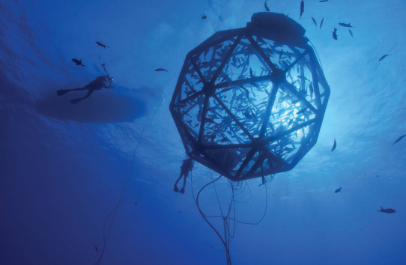
FIGURE 8. The Aquapod sea cage from the Velella Beta-test showing the cage, divers and the hull of the attendant vessel. Autonomous or semi-autonomous sea cage designs offer new options for open-ocean mariculture. Photo: Rick Decker.
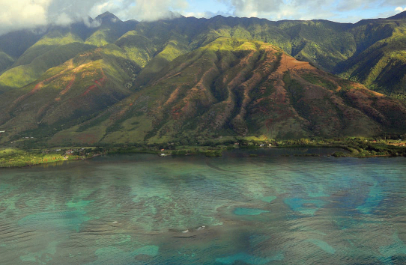
FIGURE 9. Over 400 Hawaiian fishponds existed prior to Western contact. These ponds are only two of dozens which line the Molokai shore. The fishponds are prime aquaculture sites for many species. Photo: Andre Seale.
One of the important factors in the early largely successful efforts to establish viable commercial aquaculture in Hawaiʻi and the USAPI was the coordinated efforts of the State of Hawaiʻi, UH Sea Grant, NOAA and various USDA agencies to provide targeted funding for applied research and hands-on extension services to producers. Sea Grant and CTAHR, along with the ADP, sponsored a statewide extension network that provided expert services on every island. The Center for Tropical and Subtropical Aquaculture (CTSA), the region’s USDA Regional Aquaculture Center, has also played a key role in funding numerous research projects selected by industry members since 1986. Its long list of aquaculture publications is a wealth of information documenting progress with aquaculture and is invaluable to anyone considering aquaculture in the region (see ctsa.org).
The regional and state-wide extension efforts suffered significant setbacks during the Great Recession of 2008 and its funding impacts, including the downsizing and mission change of the Aquaculture Development Program, and the collapse of the state-wide extension network. This has had a negative impact on the growth of aquaculture yet past successes established an excellent model for the new, multi-agency efforts to revive and increase aquaculture education and extension.
Joint efforts are underway to increase opportunities for aquaculture education and extension to support sustainable aquaculture development. The University of Hawaiʻi System plans to increase opportunities for participation in aquaculture education throughout the nine-campus system. Currently UH Hilo is the only campus which offers a four-year program in aquaculture but other campuses integrate aquaculture education into their programs in Animal Science, Zoology, Biology and Marine Science. Many of the community colleges have some form of aquaculture education, with aquaponics being one of the most common.
A positive indicator is the State legislature recently approved funding to revive the Aquaculture Development Program and fund the new HATCH Aquaculture Accelerator and follow-on fund. Hawaiʻi also has developed several “home-grown” business assistance/accelerator programs including the Hawaiʻi Island Business Plan Competition (HIplan) founded by shrimp culture expert Dr. Jim Wyban.
In the 1960s, Oceanic Institute (OI) began efforts to close the life cycle of grey mullet and other marine fish which led to the development of moi in conjunction with partners such as Pacific Planktonics’ Syd Kraul and other researchers (Fig. 10). Pacific Planktonics is a small company at the HOST park that has played major role in much of the original research on moi, tuna, giant grouper and other pelagic species due to the expertise of owner Syd Kraul. Moi and mullet were highly esteemed by Hawaiians and the latter was one of the principal crops produced in the ancient Hawaiian fishponds. The success in developing these native species set the pattern for later efforts to develop other species with unique characteristics and high value. OI was also instrumental in developing hatchery methods for milkfish, which were later transferred to Indonesia and other countries (Sumirasa et al. 2019), again an illustration of how R&D in Hawaiʻi has had global benefits.
The first open-ocean cage culture farm for moi, Cates International Inc., is reported to have harvested over 1 million lb of this species. Almaco jack is the third native species currently cultured. Other marine species have been extensively researched to the point where commercial aquaculture is now possible, given sufficient investment and patience with the lengthy permitting process. Others are still in the process of being developed. These include species such as mahimahi Coryphaena hippurus, bluefin trevally Caranx melampygus, milkfish Chanos chanos, red snapper Lutjanus campenchanus, giant grouper Epinephelus lanceolatus, tunas (Katsuwonus pelamis, Thunnus obesus, Thunnus albacares), aholehole Kuhlia xenura, nenue Kyphosus spp. and opakapaka Pristipomoides filamentosus.
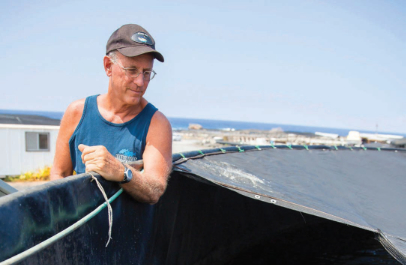
FIGURE 10. Syd Kraul, owner of Pacific Planktonics, the site of much of the early research on pelagic fish species and ornamental marine species. Photo: Joshua Decker
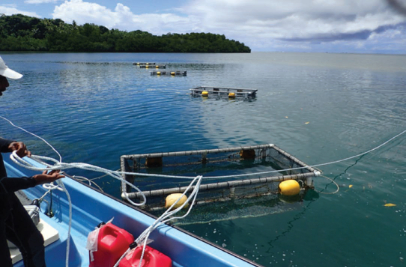
FIGURE 11. Cages culture trials for rabbitfish in Pohnpei at the MERIP, funded by the NOAA Saltonstall-Kennedy Program. The cages are stocked with juvenile fish harvested in small numbers after massive spawning events in coastal areas.
In addition, OI scientists are working with research partners in the Republic of Palau to culture coral grouper Plectropomus leopardus and in Saipan (part of the Commonwealth of the Northern Mariana Islands) to culture fork-tail rabbitfish Siganus argenteus. MERIP in partnership with the PACRC is developing capture-based methods for several species of rabbitfish Siganus spp., where larval fishes are captured during settlement and used to stock net pens (Fig. 11).
Collection of marine ornamental fish has been a long-standing practice in Hawaiʻi. Some community members oppose this practice even though monitoring by the Division of Aquatic Resources did not find significant impacts (DAR 2015). New restrictions on collection gear types have also been imposed to limit catch. Thus, new opportunities to culture native ornamental species have arisen. OI has a long record of working with such species as flame angelfish Centropyge loriculus, clownfish Amphiprion spp., and dottybacks Pseudochromis spp. In 2015, OI scientists reported the first-ever successful cultivation of captive-bred yellow tang Zebrasoma flavescens (Fig. 12), a valuable coral reef fish in high demand for the aquarium trade (Callan 2016). Off the Kona coast, more than 280,000 yellow tang are collected annually from the coral reefs and OI’s achievement in producing captive-reared fish could eventually provide aquarium hobbyists with an alternative to wild-caught fish. The PACRC has a program to conduct research on the breeding and basic biology of coral reef species, including potters angel Centropyge potteri, flame wrasse Cirrhilabrus jordani, tinkers butterfly Chaetodon tinkeri, as well as two species which are also foodfish species, peacock razorfish (Nabeta) Iniistius pavo and Achilles tang Acanthurus achilles.
Further development of marine fish is inhibited by the lack of public and private funding for existing hatcheries and the degree of investment required for commercial-scale marine fish culture. It is also challenging to obtain permits for direct seawater intake as much of Hawaiʻi’s coastline is the most regulated part of the State. Many facilities such as OI, the PACRC and Anuenue Fisheries Resource Center depend on seawater wells. Despite the additional cost of drilling wells, an advantage is the increased level of biosecurity and the ability to obtain cold and warm waters. For example, a fish farm was operated using heated water from the Puna Geothermal Plant, which provided approximately 25 percent of the electrical needs of Hawaiʻi Island.
Tilapias are the main freshwater species cultured in Hawaiʻi today, along with Chinese catfish Clarius fuscus. Over thirty years of regulatory prohibition on the importation of new tilapia stocks hampered the ability of tilapia farmers to obtain new strains, leading to inbreeding and less efficient production. Recent easing of this ban has created new opportunities for tilapia producers. There are at least two major tilapia producers, one on Oʻahu (Hawaiian Fish Company) (Fig. 13) and one at the Kohala District of Hawaiʻi Island (Kohala Mountain Fish), as well as several large aquaponics operations that grow tilapia. One of the more unique forms of aquaponics is Kulahaven Farms, which grows watercress and rainbow trout using the cooler water available at higher altitudes (Fig. 14).
OI’s Shrimp Department has an international reputation for research on the selective breeding of Pacific white shrimp Litopenaeus vannamei. In 1990, OI partnered with the University of Arizona to develop the world’s first captive population of specific pathogen free (SPF) L. vannamei and OI was the first organization in the world to develop a family-based breeding program for this species. As a member of the USDA-funded Marine Shrimp Farming Program from 1985 to 2011, OI transferred selectively-bred SPF shrimp to the private sector to promote a shrimp broodstock industry in Hawaiʻi. Hawaiʻi is now home to six commercial SPF broodstock suppliers. Shrimp exports (largely SPF broodstock) generated an estimated $24 million in export revenue in 2018 (United States Census Bureau 2019). Two of the largest SPF shrimp broodstock companies have been operating out of HOST Park (Shrimp Improvement Systems Hawaii LLC and Moana Technologies LLC) for over a decade.
Sunrise Capital, Inc. operates a 44-acre shrimp farm on Kauai that produces SPF/SPR shrimp broodstock and also sells for consumption. This company also cultures hard clams and Pacific oysters. Shrimp grow-out has continued, largely located on the North Shore of Oʻahu, but land prices and regulations constrain further development of shrimp farming for the purpose of consumption.
Among other early accomplishments, researchers at the AFRC developed culture methods for Malaysian prawns Macrobrachium rosenbergii that supported development of 20 commercial prawn farms by 1982 (Ogata 1982). Production peaked in 1983 with 373 t valued at $3.3 million from 22 farms with about 281 ha of pond area. Due to relatively low yields for the production effort, the industry has since declined to just six farms in 1999, producing only about 18 t (Fast and Leung 2003). Although no official statistics are available since then, commercial prawn production is believed to be quite small, supplying a local niche market, but the opportunity exists for expansion of this activity.
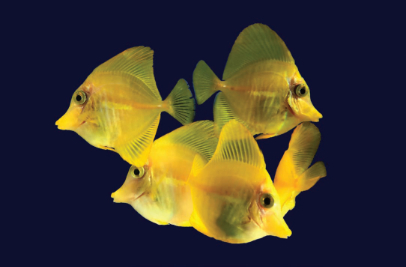
FIGURE 12. Captive-bred yellow tang (Zebrasoma flavescens). OI scientists recently closed the life cycle on this important coral reef fish and now have sexually mature, F2 generation adults. Photo: Chatham Callan, OI.
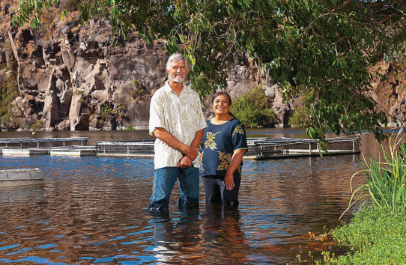
FIGURE 13. Ron and Lita Weidenbach of the Hawaiʻi Fish Company, the oldest land-based commercial fish farm in Hawaiʻi. Ron has also served as the President of the Hawaiʻi Aquaculture and Aquaponics Association (HAAA) for many years. Photo: Ron Weidenbach.
Four large commercial oyster and clam hatcheries (Hawaiian Shellfish LLC, Jamestown Point Whitney Ventures, Kona Coast Shellfish LLC, Taylor Shellfish) and two research hatcheries (PACRC and Pacific Hybreed) operate on Hawaiʻi Island. These hatcheries supply a significant amount of oyster and clam seed to the West Coast shellfish industry and new Hawaiian farms. The Hawaiʻi hatcheries are also important on a national basis and have been a lifeline to West Coast producers, whose hatcheries have been affected by ocean acidification.
Hawaiʻi has a long history growing bivalve molluscs such as oysters and clams, with first efforts focusing on non-native species. The Pacific oyster Crassostrea gigas is the main culture species with modern farming efforts starting in 2010, when the Department of Health began to implement elements of the State Shellfish Plan that pertain to water quality monitoring and classification of shellfish growing areas. Currently production efforts are developing on Kauai, Hawaiʻi Island, Oʻahu and Molokai. Kualoa Ranch now operates the largest oyster farm in Moliʻi fishpond. Eastern oysters Crassostrea virginica and Kumamoto oysters C. sikamea have also been cultured. Limited numbers of Eastern oysters still exist in Pearl Harbor, where they were first introduced in the 1860s. The PACRC is working to “rescue” these relic stocks for future aquaculture use. Hawaiʻi was also the site of early attempts to developed land-based oyster culture systems in intensive raceways (Yamaguchi et al. 1983). The PACRC is currently testing a similar system using fish effluent in partnership with the newly incorporated Hilo Aquaculture.
The Big Island Abalone Corporation at HOST park has been producing abalone, primarily for export to Japan, for over twenty years. Pearl farming has also been tested in Hawaiʻi and the USAPI. A new effort is currently underway with oyster and pearl farming is underway for Hilo Bay. Opihi (Hawaiian limpets) are another high-value mollusc that has spurred considerable research (Hua 2014) but there is no commercial production to date. Most recently, native Hawaiian oysters Dendostrea sandvicensis are being used by the Waiwai Ola Waterkeepers for water quality mitigation purposes at six sites and trials for commercial production are overseen by the PACRC staff.
Large-scale production of microalgae was started at HOST Park in 1983 by Cyanotech Corporation, which began with Spirulina and now produces Haematococcus pluvialus for the extraction of astaxanthin. The vertically integrated company now utilizes 90 acres of ponds and has its own processing plant. Several other companies have entered the field over the years, many of which focused on research.
Interest in seaweed culture is also on the rise. Hawaiians use over 70 species of seaweed (called limu in Hawaiian), but now only three species are regularly cultured and two of these are non-native. Most of the commercial seaweed production comes from Royal Hawaiian Sea Farms (HOST park), Olakai, Inc. (Oʻahu) and smaller operations around the State. Olakai Inc. also produces sea asparagus Salicornia spp. in its shrimp ponds.
Limu is still collected from the wild, but there is concern that over-collecting, restriction of freshwater flows and environmental degradation are negatively impacting wild populations (McDermid et al. 2018). This led Wally Ito to establish a small demonstration facility for native seaweed species at AFRC (Fig. 5), the non-profit Kuaʻāina Ulu ʻAuamo (KUA). KUA convenes the limu hui (group of seaweed practitioners) to bring awareness to the need to protect seaweed species and their environment and to work towards restoration and culture of native species. Researchers at UHH were partially successful in closing the life cycle of Asparagopsis taxiformis (limu kohu), a high-value, iconic Hawaiian seaweed. The news that feeding limu kohu to cattle can nearly eliminate methane production has stirred new interest in this species.
Hawaiʻi has a long history of research on diverse species, many of which have not found their way into commercial aquaculture, yet remain of interest. One of the most innovative efforts involves culture of collector urchins Tripneustes gracilis as a biocontrol to curb the growth of invasive seaweed that smothers native corals (Fig. 15). Outplanted urchins graze on the invasive species, giving native coral species a fighting chance to grow back. The sea urchin hatchery at AFRC has released over 500,000 sea urchins on more than 60 acres of impacted area over the last eight years. The urchins are successful in preventing the rapid re-growth of invasive seaweed species.
Several innovative companies at HOST Park in Kona produce, sell or research other rare products such as octopus (Kanaloa Octopus Farms, Silver Spiral Seas), corals (Kohana Kai Aquafarms), and many species of marine invertebrates (Indo-Pacific Sea Farms).
Hawaiʻi’s population of 1.4 million people imports more than 88 percent of their food, including 49 percent of their seafood (Loke and Leung 2013). Large segments of the population are food insecure (Hawaii Health Matters 2019) and diseases related to poor diet (e.g. diabetes) are rampant. Aquaculture can be an important means of addressing these issues but well-known obstacles such as complex and inhibitory regulations and permitting still stand in the way. Even with the existing challenges, the value of aquaculture production has been a consistent and growing contributor to Hawaiʻi’s agricultural economy and, in 2017, “other” aquaculture and algae values combined would rank fourth in agriculture products values and together comprised over 13 percent of the $564 million in total agricultural production (NASS 2018). While algae and broodstock shrimp have been steady and major contributors, expansion of other existing and new species could potentially increase the size of the aquaculture sector and its benefits to society.
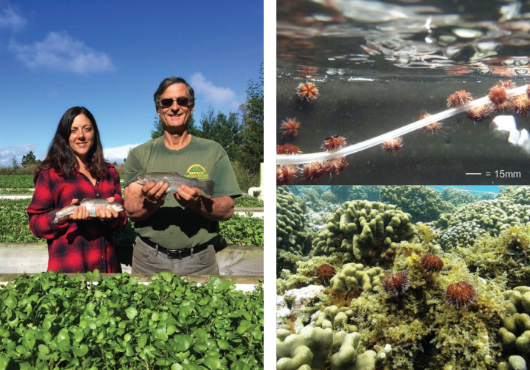
FIGURE 14. John Dobovan and Aimee Greenwood of Kulahaven Farm, which produces rainbow trout and watercress. Photo: John Dobovan.
FIGURE 15. Small sea urchins produced at the AFRC (top) and after out planting on a reef to fight invasive seaweed (bottom). Photo: David Cohen, DAR.
Growing public and political awareness of the need for local sustainable food production and the need to assume responsibility for food security, rather than reliance on imported sources, may help ease the regulatory barriers. The urgency to increase local food security is heightened by the growing impacts associated with climate change. Various forms of aquaculture increase resiliency to climate change impacts and make contributions to natural resource management.
Several opportunities stand out as prime targets for investment and future R&D. In part due to Hawaiʻi’s past legacy in aquaculture and in part due to its prime location and resources, the State is positioned to continue making significant contributions to world aquaculture in terms of technology and innovation. Hawaiʻi’s aquaculture community has a proven track record for innovation, the experience, the mentors and the political will continue to play an important role. For example, many of the new startups at HOST Park are companies that focus on technologies that will eventually be transferred to others to benefit world aquaculture. These include better growth management through improved sensors and data analysis, improved and more sustainable feeds, improved health and traceability mechanisms.
Hawaiʻi is also known for hatchery operations that are diverse and have the capability of producing dozens of species. More support is needed to fully realize the potential of these operations and to stabilize hatchery production for local small farmers, which tends to fluctuate based on funding. Hawaiʻi’s hatcheries can provide the basis for more local grow-out operations, both land- and ocean-based. Hatchery production of certified high-health animals and plants turns Hawaiʻi’s geographic isolation into a competitive advantage and an international exporter of high-value products.
Although open-ocean aquaculture is currently only represented by one farm near Kailua-Kona, the permitting process is now well-articulated, although still time-consuming, expensive and encounters public opposition. The possibility of moving farming into federal waters offers an opportunity to overcome this and new systems such as the Kampachi Farm’s submerged seaweed farm may offer alternatives.
Another bright spot in aquaculture are the efforts to restore the ancient Hawaiian fishponds to increase their contributions to local food security and preservation of traditional cultural practices. Recent efforts to streamline the permitting process for restoration has been a significant step forward but more needs to be done to assist practitioners and community members who still struggle with the costs, complex permitting and environmental impacts from surrounding terrestrial areas.
Finally, Hawaiʻi offers unique and invaluable assets to support a robust aquaculture industry. The advantage of its isolation and high degree of biosecurity are clearly shown by the thriving SPF shrimp industry. Six decades of research have provided ample demonstration of the biological feasibility of culturing dozens of warm- and cold-water species. If the political will exists to temper or remove obstacles such as permitting difficulties (many of which also impact other forms of agriculture), more of these well-researched species could be farmed. The clear benefits of easing the regulatory environment for responsible farming can be seen at NELHA, where the combination of pre-permitting, technical assistance and infrastructure enable the larger and small companies to establish and grow. The recent support from the state legislature for business assistance and revival of the Aquaculture Development Program has been applauded by industry. The future for aquaculture to make a big difference in Hawaiʻi and the world is clear.
Aquaculture Development Program, Department of Land and Natural Resources, State of Hawaii. 1981. Mariculture and Ocean Thermal Energy Conversion State-of-the-Art Assessments. A technical supplement to Ocean Leasing for Hawaii. 1981.
Aquaculture Planning & Advocacy, LLC. 2014. Environmental Assessment, A Commercial Sea Cage Facility for Moi Aquaculture in the Reef Runway Borrow Pit in Keehi Lagoon, Honolulu, Oʻahu, Hawaiʻi. Prepared for Office of Conservation and Coastal Lands Department of Land and Natural Resources. Accessed at: http://dlnr.hawaii.gov/occl/files/2013/08/MBS_Draft-EA_05-15-14.pdf
Callan, C.K. (2016) Striking Gold: the dream of breeding Zebrasoma flavescens comes true in a Hawaii marine lab. CORAL 12:36-49.
Cates, R. 2006. Cates International. Presentation to the Pew Commission. Accessed at: https://www.whoi.edu/cms/files/jmcdowell/2006/7/Cates_international_12247.pdf
Chen, J.Q., M.C. Haws, Q.S. Fong, and P.S. Leung. 2017. Economic feasibility of producing oysters using a small-scale Hawaiian fishpond model. Aquaculture Reports 5:41-51.
Corbin, J.S. Aquaculture in Hawaii 1976. Progress, Resources and Organization. Prepared for the Department of Planning and Economic Development. January 1976. Honolulu, Hawaii.
Corbin, J.S. Hawaii aquaculture development: Twenty-five years and counting, lessons learned. In: Species and Systems Selection for Sustainable Aquaculture. Eds: P.S. Leung, C.-S. Lee and P.J. O’Bryen. Published in Cooperation with the United States Aquaculture Society, W.O. Watanabe, USAS Publications Chair. Blackwell Publishing. 2007.
Costa-Pierce, B.A. 1987. Aquaculture in ancient Hawaii. BioScience 37(5):320-331.DHM Planners Inc. 1990. Bernice Pauahi Bishop Museum, Applied Research Group, Public Archaeology Section and Moon, O’Connor, Tam & Yuen. Hawaiian Fishpond Study: Islands of Hawaiʻi, Maui, Lānaʻi and Kauaʻi. Honolulu: DHM Planners, 1990.
Department of Business, Economic Development & Tourism. Visitor statistics 2018. Accessed at: http://files.hawaii.gov/dbedt/visitor/visitor-research/2018-annual-visitor.pdf
Division of Aquatic Resources (DAR). 2015. Report on the Findings and Recommendations of Effectiveness of the West Hawaiʻi Regional Fishery Management Area. Report to the Thirtieth Legislature 2015 Regular Session. Accessed at: https://dlnr.hawaii.gov/dar/files/2015/01/ar_hrs188_2015.pdf
Fast, A.W. and P.S. Leung. 2003. Rise and fall of freshwater prawn (Macrobrachium rosenbergii) culture in Hawaii: 1965-1999. Reviews in Fisheries Science, 11(3):243-290.
Hawaii, Aquaculture Planning Program. 1978. Aquaculture Development For Hawaii: Assessment and Recommendations. Honolulu: pp. 183-190.
Hawaii Department of Health and Hawaii Health Database Warehouse. 2019. Hawaii Health Matters. Accessed at: Hawaiihealthmatters.org
Helsley, C.E. 2007. Environmental observations around offshore pens in Hawaii. Pages 41-44 In C.S. Lee and P.J. O’Bryen (eds). Open Ocean Aquaculture – Moving Forward. Oceanic Institute, Hawaii.
Hiatt, R.W. 1944. Food-chains and the food cycle in Hawaiian fish ponds.-Part I. The food and feeding habits of mullet (Mugil cephalus), milkfish (Chanos chanos) and the ten-pounder (Elops machnata). Transactions of the American Fisheries Society 74:250-261.
Honolulu Star Advertiser. 2015. Shrimp beats out bottled water as Hawaii’s top edible export. December 13, 2015.
Hua, N.T. 2014. Development of aquaculture technology for the Hawaiian opihi, Cellana spp. Doctoral dissertation. Molecular Sciences and Biotechnology. University of Hawaii Mānoa. Accessed at: https://scholarspace.manoa.hawaii.edu/bitstream/10125/100431/Hua_Nhan_r.pdf
Kampachi Farms. 2019. Environmental assessment for an offshore native macroalgae demonstration project off Kaiwi Point, Kona, Hawaii. Accessed at: https://static1.squarespace.com/static/5307ba1ae4b0e7fa5a1becab/t/5d7063214161ce00017a2d38/1567646504614/FINAL+MARINER+EA_Final.pdf
Kikuchi, W.K. 1973. Hawaiian aquacultural systems. Ph.D. dissertation, University of Arizona, Tucson.
Loke, M., C. Geslani, B. Takenaka and P.S. Leung. 2012. Seafood consumption and supply sources in Hawaiʻi, 2000-2009. Marine Fisheries Review 74(4):44-51.
McDermid, K.J., K.J. Martin and M.C. Haws. 2019. Seaweed resources of the Hawaiian Islands. Botanica Marina 62(5):443-462.
NASS. 2018. Aquaculture: number of operations, production and value, by counties, 2017. U.S. Dep. Agric., Natl. Agric., Stat. Serv., Hawaii Annu. Rep., 2 p.
Ogata, A.M. 1982. Marine resources and aquaculture programs in the State of Hawaiʻi. Legislative Reference Bureau, State Capitol, Report No. 3. Honolulu, Hawaii. Accessed at: http://lrbhawaii.info/lrbrpts/78/aquaculture.pdf.
Sumirasa, G., F. Cholick, T. Ahmad, K. Aida, C-S. Lee, H. Ako and C.S. Tamaru. 2019. Status of milkfish culture in Indonesia: an example of what happens when technology changes. World Aquaculture (March 2019):38-44.
Szyper, J.P., K.D. Hopkins, W. Malchow, and W.Y. Okamura. 2000. History and prospects of tilapia stocks in Hawaii, U.S.A. Pages 663-672. In: K. Fitzsimmons and J. Carvalho Filho (eds.), Tilapia Culture in the 21st Century - Proceedings from the Fifth International Symposium on Tilapia Aquaculture, Rio de Janeiro, Brazil.
Tokunaga, K., C. Tamaru, H. Ako and P.S. Leung. 2015. Economics of small-scale commercial aquaponics in Hawaiʻi. Journal of the World Aquaculture Society 46:20-32.
United States Census Bureau. 2019. State exports from Hawaii. Accessed at: https://www.census.gov/foreign-trade/statistics/state/data/hi.html
Yamauchi, H., K.K.F. Lee and H.K. Gee. 1983. An overview of land-based oyster aquaculture in Hawaii. College of Tropical Agriculture and Human Resources, University of Hawaiʻi. Honolulu, Hawaiʻi.
Maria Haws, Pacific Aquaculture and Coastal Resources Center, University of Hawaiʻi Hilo
Andre P. Seale, Department of Human Nutrition, Food and Animal Sciences, College of Tropical Agriculture and Human Resources, University of Hawaiʻi Manoa
John Corbin, Aquaculture Planning and Advocacy, LLC
Shaun Moss and Chatham Callan, Oceanic Institute, Hawaiʻi Pacific University
RuthEllen Klinger-Bowen, Research Corporation of University of Hawaiʻi Mānoa and University of Hawaiʻi Sea Grant College Program
Brenda Asuncion, Kuaʻāina Ulu ‘Auamo
Clyde Tamaru, University of Hawaiʻi (retired)
Laurence Sombardier, National Energy Laboratory Hawaiʻi Authority (NELHA)
Ron Weidenbach, Hawaiʻi Fish Company
PingSun Leung, Department of Natural Resources and Environmental Management, College of Tropical Agriculture and Human Resources, University of Hawaiʻi Mānoa
Neil Anthony Sims, Kampachi Farms
David Cohen, Division of Aquatic Resources, State of Hawaiʻi
Lei Yamasaki, Hawaii Department of Agriculture